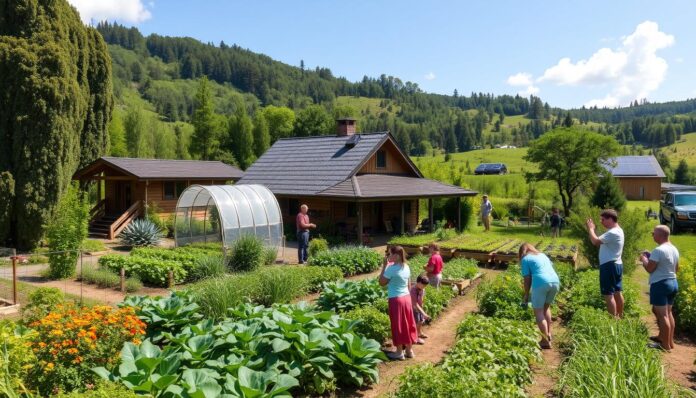More and more people want to travel in a way that’s good for the planet. About 68% of travelers now look for places to stay that are eco-friendly. So, what can permaculture tourism do to help? It uses 12 principles to make travel more sustainable and friendly to the environment.
By using permaculture in tourism, places can cut down on carbon emissions by up to 30%. This is shown in a 2019 report. To learn more about how permaculture helps in sustainable tourism, check out permaculture tourism services.
Key Takeaways
- Permaculture tourism services can reduce the environmental impact of tourism while promoting local economic benefits.
- Approximately 68% of travelers prefer eco-friendly accommodations that align with sustainable practices.
- Sustainable tourism can reduce carbon emissions by up to 30% compared to traditional tourism methods.
- Permaculture principles can be applied to various life aspects, including travel, to create sustainable and eco-friendly experiences.
- The global green tourism market is projected to grow at a CAGR of 11.4%, reaching $1.62 trillion by 2027.
- Destinations that encourage “slow travel” see an increase in local economic benefits, with 83% of tourism revenue staying in the local community.
Understanding Permaculture Tourism
Permaculture tourism is a special way to travel that blends sustainable tourism with permaculture’s principles. It was started in the 1970s by Australians Bill Mollison and David Holmgren. They aimed to make a balance between people and nature.
Permaculture visitor spots are built with nature in mind. They try to leave a small mark on the environment while giving visitors unforgettable moments.
At its core, permaculture tourism is about sustainable travel. It’s not just about lessening the harm of tourism. It’s also about helping local communities thrive. By choosing permaculture tourism, visitors help in sustainable growth and protect nature for the future.
Definition and Concepts
Permaculture tourism focuses on eco-friendly design and practices. It uses rainwater, composting, and more to cut down on non-renewable use. This way, visitor spots can lessen their harm on the environment while offering special experiences.
Importance in Sustainable Development
The role of permaculture tourism in sustainable growth is huge. It supports local communities and helps keep nature and culture alive. As more people seek green travel, permaculture tourism is set to become even more vital in the tourism world.
Key Elements of Permaculture
Permaculture is a way to design sustainable environments. It focuses on three main ethics: care for the earth, care for people, and fair share. These ethics help guide the creation of green spaces and eco-friendly facilities.
The design principles of permaculture aim for self-sufficiency and less waste. This is key for eco-friendly tourism. Some important principles include:
- Observe and interact with nature
- Catch and store energy
- Obtain a yield
- Apply self-regulation and accept feedback
- Use and value renewable resources and services
Ethics of Permaculture
The ethics of permaculture are simple yet powerful. They remind us to care for the earth and all living things. By following these ethics, we can work towards a more sustainable and fair world. These ethics apply to many areas, like designing green spaces and promoting eco-friendly tourism.
Principles of Design
The design principles of permaculture offer a framework for sustainable systems. They can be used in many settings, from small gardens to large eco-friendly facilities. By using these principles, we can create environments that are sustainable, thriving, and resilient.
Benefits of Permaculture Tourism Services
Permaculture tourism services bring many benefits. They help local economies grow and create jobs. They also help the environment and bring communities together. By offering nature-based accommodations and sustainable guest services, they support local businesses.
Studies show that rural tourism can diversify local economies. This helps in local development and community engagement.
Permaculture tourism also has big environmental benefits. It uses eco-friendly amenities and practices. This reduces the need for harmful chemicals, saving money and protecting the environment.
In New Zealand, a study found a 30% drop in pesticide use. This is thanks to more biodiversity, which helps with natural pest control.
Some key benefits of permaculture tourism services are:
- Creation of jobs and promotion of local economies
- Preservation of natural resources and reduction of waste
- Community involvement and engagement in sustainable practices
Permaculture practicecan lead to an increase of 20-30% in crop yields due to improved soil health metrics.
Permaculture tourism services are a unique and sustainable way. They promote local economies, preserve natural resources, and engage communities in sustainable practices.
| Benefits | Description |
|---|---|
| Economic Advantages | Creation of jobs, promotion of local economies |
| Environmental Impact | Preservation of natural resources, reduction of waste |
| Community Involvement | Engagement in sustainable practices, community development |
Types of Permaculture Tourism Services
Permaculture tourism services offer many activities and experiences. They promote sustainable development and protect the environment. Visitors can learn about permaculture at permaculture visitor facilities. These places have workshops, guided tours, and hands-on experiences.
Workshops and Educational Programs
Workshops and educational programs are key in permaculture tourism. They teach about Earth Care, People Care, and Fair Share. Visitors can also try organic farming, natural building, and renewable energy.
Guided Tour Experiences
Guided tours are another service. They let tourists see permaculture farms and gardens. Visitors can also learn about local culture and support sustainable tourism.
Agritourism and Farm Stays
Agritourism and farm stays let tourists live like locals. They can help with farm work and enjoy organic meals. These stays offer eco-friendly amenities and sustainable living.
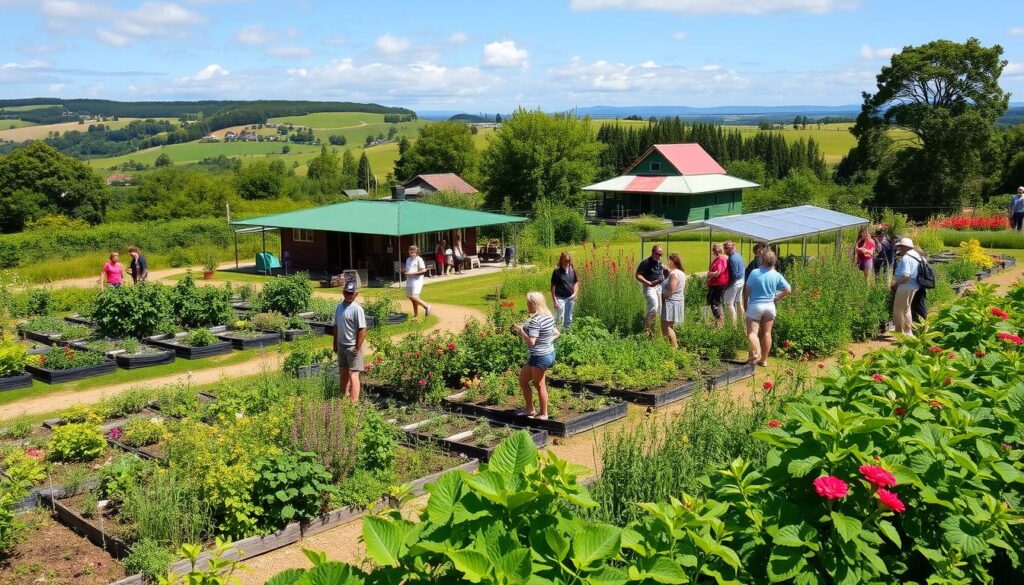
Eco-Friendly Accommodations
Eco-friendly accommodations are vital in permaculture tourism. They provide a green place to stay and support local communities. These places have organic meals, renewable energy, and sustainable waste management.
Marketing Strategies for Permaculture Tourism
As more people seek regenerative tourism, it’s key to market permaculture tourism well. We need to highlight eco-friendly facilities and nature-based stays. By knowing our audience and being online, we can share sustainable tourism with more people.
Some important marketing tactics for permaculture tourism are:
- Target audience identification: figuring out who might visit
- Online presence: having a website and social media to show off and talk to visitors
- Collaborations with eco-conscious brands: working with other green businesses to boost sustainable tourism
Using these strategies, permaculture tourism can get more noticed, draw in more guests, and help regenerative tourism grow.
| Marketing Strategy | Benefits |
|---|---|
| Target audience identification | More effective marketing |
| Online presence | Reach more people and get seen more |
| Collaborations with eco-conscious brands | Builds trust and reputation |
Operational Considerations
Permaculture tourism focuses on creating a green and educational experience for visitors. It involves choosing the right site, following local laws, and building eco-friendly structures. This way, permaculture sites can reduce their harm to the environment while offering a special and learning-filled visit.
Important things for permaculture tourism operators to think about include:
- Using green amenities like solar power and recycling
- Building structures that are good for the planet and last long
- Creating educational programs that teach about green tourism and help local areas
By paying attention to these details, permaculture tourism can positively affect the environment and local communities. It also gives visitors a memorable and enriching experience. 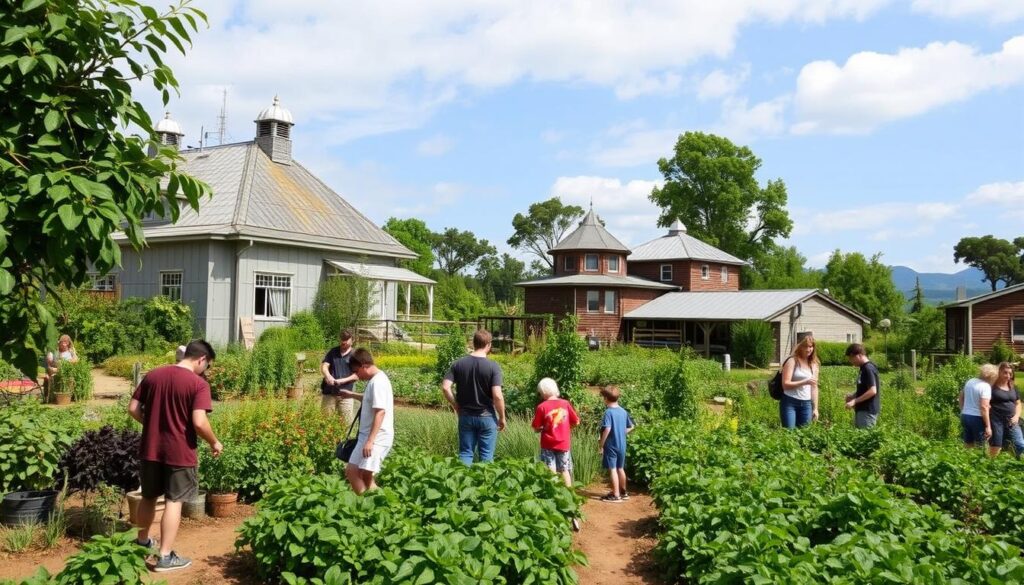
| Permaculture Tourism Operator | Eco-Friendly Amenities | Sustainable Infrastructure |
|---|---|---|
| Wolffer Estate Vineyard | Drip irrigation system | Solar-powered facilities |
| Featherdown Farm | Organic farm stays | Renewable energy systems |
| Polyface Farm | Regenerative agriculture practices | Sustainable waste management |
Staffing and Training Needs
To make permaculture tourism successful, having a knowledgeable team is key. This means hiring experts and training them in permaculture. Many places are using green infrastructure and regenerative tourism practices. These need special skills and knowledge.
Some projects offer internships or volunteer spots. These give hands-on experience in permaculture. They happen in environmentally conscious facilities. It’s a chance to learn about sustainability and help the local community.
For great customer service, projects need to train staff well. They should learn about talking to people, being culturally aware, and solving problems. This can be through workshops, online classes, or on-the-job training.
By focusing on staffing and training, permaculture tourism can offer a top-notch experience. It also promotes green practices and supports local areas.
Building Partnerships
Building partnerships is key in permaculture tourism. It helps create nature-based accommodations and sustainable guest services for eco-aware travelers. By teaming up with local farmers, operators can offer eco-friendly amenities like organic food and green transport.
Some main perks of partnerships in permaculture tourism are:
- Access to local knowledge and expertise
- Opportunities for skill-sharing and capacity-building
- Enhanced credibility and reputation
- Increased support for local economies
For instance, permaculture tourism operators can team up with local farmers. They can offer workshops on sustainable agriculture practices. They also promote eco-friendly amenities like composting toilets and solar lights.
By working together, they create special experiences for travelers. They also support the local economy and push for sustainable growth.
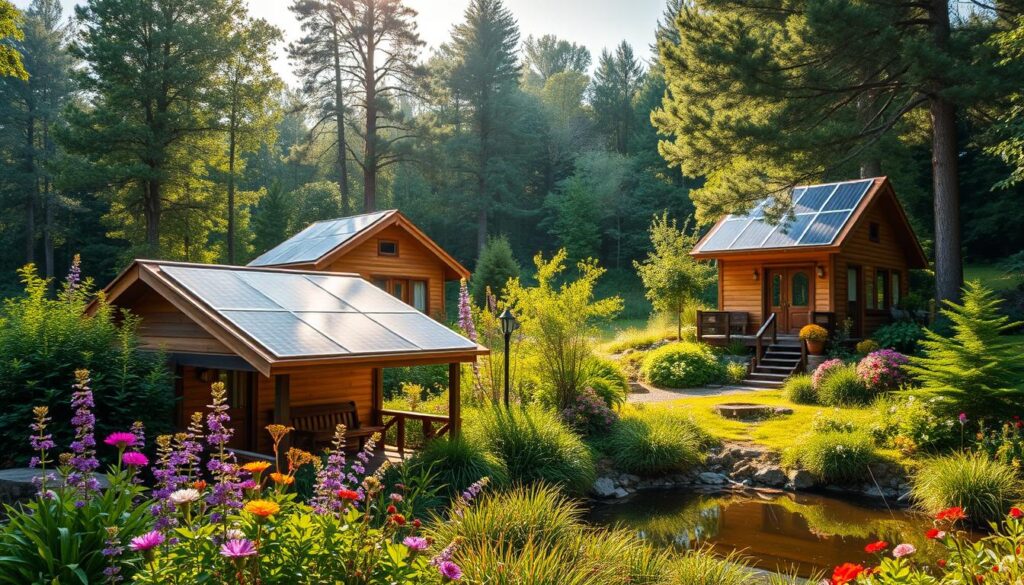
By teaming up with environmental groups and travel agencies, permaculture tourism operators can reach more people. They can also spread the word about sustainable guest services and eco-friendly amenities to more folks.
| Partnership Type | Benefits |
|---|---|
| Local Farmers | Access to local knowledge and expertise, opportunities for skill-sharing and capacity-building |
| Environmental Organizations | Enhanced credibility and reputation, increased support for local economies |
| Travel Agencies | Expanded reach and impact, promotion of sustainable guest services and eco-friendly amenities |
Pricing Models for Services
Pricing is key in permaculture tourism. It helps attract visitors to permaculture sites. Operators must find a balance between making money and keeping prices low. They can do this by looking at what others charge and setting prices that way.
Another method is value-based pricing. This means setting prices based on what customers get. For instance, offering organic meals and unique stays can mean higher prices. Discounts and packages can also draw in new and loyal customers.
- Know your target market and what they can afford.
- Check out the competition and their pricing.
- Figure out the costs of your service, like labor and materials.
- Think about the value you offer and price accordingly.
By thinking about these points and finding a good pricing balance, permaculture tourism can thrive. It can attract visitors and help the local economy grow.
Creating a Memorable Visitor Experience
Regenerative tourism aims to positively impact the environment and local communities. It’s about giving visitors more than just a sightseeing trip. Personalized tours and activities help visitors connect with local culture and nature.
Environmentally friendly facilities and nature-based stays are key. They help reduce tourism’s environmental impact. Visitors can learn about sustainable practices and local traditions through workshops and guided tours.
What makes a visit memorable? Here are some important points:
- Personalized tours and activities
- Interactive learning opportunities
- Immersive cultural experiences
- Environmentally conscious facilities and nature-based accommodations
By focusing on these, regenerative tourism can make a difference. It benefits the environment and local communities. And it gives visitors a unique and unforgettable experience.
| Type of Accommodation | Environmental Impact | Visitor Experience |
|---|---|---|
| Nature-based accommodations | Low environmental footprint | Immersive and unique experience |
| Environmentally conscious facilities | Reduced waste and energy consumption | Educational and interactive experience |
Utilizing Technology in Permaculture Tourism
Permaculture tourism is changing with new technology. This makes visits better and helps the planet. It’s all about using green tech, regenerative tourism, and eco-friendly places.
By using tech, permaculture tourism can reach more people. It keeps its focus on caring for the environment and building community.
Booking and Reservation Systems
Good booking systems are key for permaculture tourism. They let visitors plan and book easily. These systems also help make tourism greener by cutting down on carbon emissions.
Virtual Tours and Online Classes
Virtual tours and online classes offer a deep dive into permaculture. They teach visitors about sustainable living and farming. This is great for showing the good side of eco-friendly tourism.
Mobile Apps for Visitor Engagement
Mobile apps are great for keeping visitors engaged. They offer maps, tips for green travel, and places to talk. This helps spread the word about eco-friendly places and practices.
| Technology | Benefits |
|---|---|
| Booking and Reservation Systems | Efficient planning and booking, reduced carbon footprint |
| Virtual Tours and Online Classes | Immersive and interactive experience, promotion of regenerative tourism |
| Mobile Apps | Visitor engagement, promotion of environmentally conscious facilities and practices |
Measuring Success in Permaculture Tourism
Measuring success in permaculture tourism means tracking important indicators. These show how sustainable tourism affects the environment, local communities, and the economy. Places that offer permaculture visitor facilities and eco-friendly amenities help a lot.
Some key performance indicators (KPIs) for success in permaculture tourism are:
- Visitor feedback and surveys to check the quality of the experience
- Financial metrics, like revenue and profit, to see if it’s economically viable
- Environmental metrics, such as carbon footprint and waste reduction, to measure sustainability
By using permaculture principles and offering eco-friendly amenities, tourism can help the environment and local communities. As more people look for sustainable travel, permaculture tourism is set to grow. It will help make tourism more environmentally friendly and support local economies.
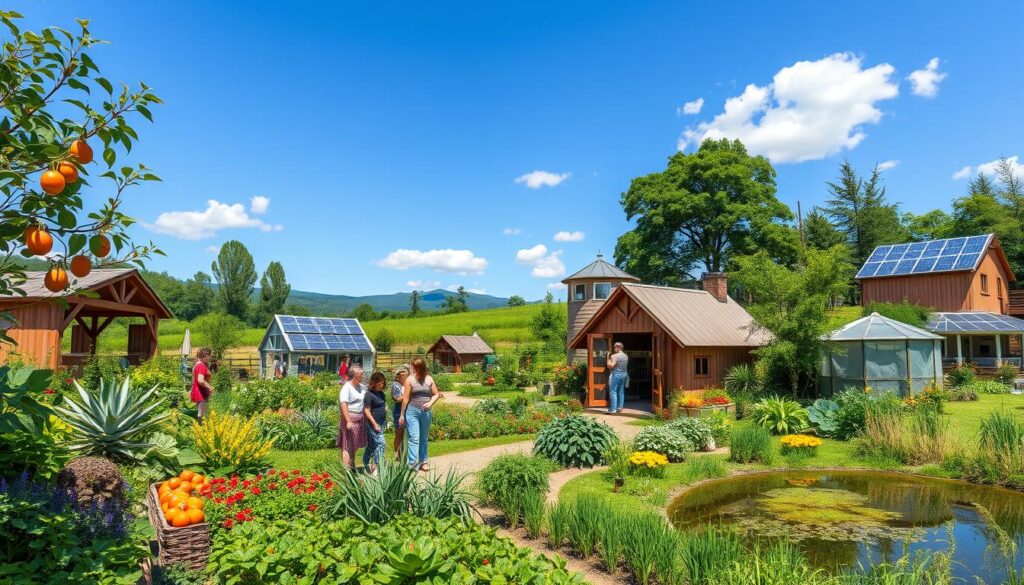
Case Studies of Successful Permaculture Tourism
Permaculture tourism has been a hit worldwide, offering new ways to travel sustainably. The Chikukwa Permaculture Project in Zimbabwe is a prime example. It’s been around for nearly 35 years, showing how polyculture farming can boost local communities.
The Take 3 for the Sea program is another success story. It’s kept over 56 million pieces of trash out of the oceans and taught over 1 million students about plastic pollution. These efforts highlight how permaculture tourism can lead to a greener future.
Many permaculture tourism spots offer nature-based accommodations and sustainable guest services. Think eco-lodges and organic farms. These places not only give tourists memorable experiences but also help local communities and the environment. Plus, they often use eco-friendly amenities like solar power and recycling to reduce their footprint.
| Initiative | Location | Impact |
|---|---|---|
| Chikukwa Permaculture Project | Zimbabwe | Increased community resilience and environmental conservation |
| Take 3 for the Sea | Global | Prevented over 56 million pieces of litter from decomposing in oceans |
Challenges in Permaculture Tourism
Permaculture tourism has to deal with seasonal changes and weather. These issues can really impact the success of these projects. About 45% of them face problems with government rules, and 75% struggle to get noticed.
To beat these hurdles, permaculture tourism needs to focus on being green and working with the community. This means teaming up with local businesses and offering lessons on living sustainably. In fact, 55% of people want to learn about sustainability when they visit.
- Seasonal variability and weather impact
- Government regulations and policies
- Marketing and visibility
- Community involvement and partnerships
- Reliable water and energy resources
| Challenge | Percentage of Initiatives Affected |
|---|---|
| Seasonal variability and weather impact | 50% |
| Government regulations and policies | 45% |
| Marketing and visibility | 75% |
By tackling these challenges head-on and choosing sustainable paths, permaculture tourism can thrive. It can offer special, educational trips that help the planet and support local areas.
Future Trends in Permaculture Tourism
Permaculture tourism is on the rise, thanks to growing interest in eco-tourism. It focuses on green infrastructure and regenerative tourism. This makes it a unique and sustainable way to explore nature.
One big trend is the creation of environmentally conscious facilities. These places aim to harm the environment less. They use sustainable materials and practices to cut down waste and save resources. Examples include:
- Eco-lodges and sustainable accommodations
- Organic farms and gardens
- Renewable energy systems and green infrastructure
Permaculture tourism also offers many activities. Visitors can join workshops, guided tours, and volunteer projects. These experiences teach about permaculture and let people help with sustainable projects.
Permaculture tourism is a special way to see the world while helping the environment. It supports local communities and encourages conservation. As more people seek eco-friendly travel, permaculture tourism will likely become even more popular.
| Trend | Description |
|---|---|
| Green infrastructure | Development of sustainable facilities and systems |
| Regenerative tourism | Focus on restoring and regenerating natural environments |
| Environmentally conscious facilities | Design and operation of facilities to minimize environmental impact |
Resources for Further Learning
If you’re eager to learn more about permaculture tourism, there’s a lot to explore. Start with the Our Permaculture Life YouTube channel. It has over 100 permaculture how-to films. The Our Permaculture Life Blog also has nearly 500 articles on permaculture topics.
Online courses and webinars are great for learning more. The Masterclass 23 offers quick tips on growing food during the pandemic. Masterclass 16 shows how to create a small, thriving edible garden.
For hands-on learning, consider the Permaculture Design Certificate (PDC) Course by Midwest Permaculture. It’s a 72-hour course available in-person or online. It covers permaculture design and its practical uses.

